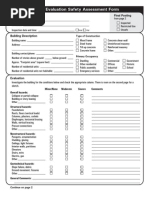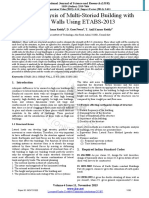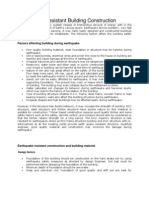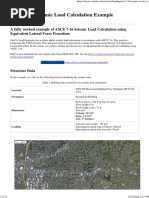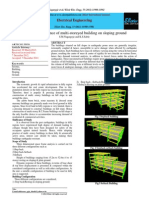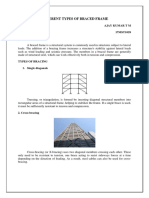Shear Wall
Shear Wall
Uploaded by
IjazCopyright:
Available Formats
Shear Wall
Shear Wall
Uploaded by
IjazOriginal Description:
Copyright
Available Formats
Share this document
Did you find this document useful?
Is this content inappropriate?
Copyright:
Available Formats
Shear Wall
Shear Wall
Uploaded by
IjazCopyright:
Available Formats
Concept of Shear Walls
Chapter 1
INTRODUCTION
Shear walls are vertical elements of the horizontal force resisting system. Shear walls
are constructed to counter the effects of lateral load acting on a structure. These walls
generally start at the foundation level and are continuous throughout the building
height. In residential construction, shear walls are straight external walls that typically
form a box which provides all of the lateral support for the building. Due to the
increase in construction of tall and slender structures, the effects of lateral loads like
wind loads, earthquake loads have attained considerable importance.
Under the earthquake resistant building design, the orientation of these walls in
building plans is done such that lateral displacements under earthquake loads are
reduced. Structures made of shear walls have high lateral strength, and also have the
capability to resist the seismic force, wind forces and through adoption of various
ground improvement techniques they even can be build on soils of weak bases. The
strength parameters and effectiveness to bare horizontal loads is very high and also
when the economical aspect is considered the quickness in construction process is
higher. Though these types of constructions have their origin in western nations in
early 90s, this ideology has changed rapidly and spread all over the world with in no
time. The form work used in this type of construction is of a new kind in Indian
construction scenario.
In building construction, a rigid vertical diaphragm capable of transferring lateral
forces from exterior walls, floors, and roofs to the ground foundation in a direction
parallel to their planes. Lateral forces caused by wind, earthquake, and uneven
settlement loads, in addition to the weight of structure and occupants; create powerful
twisting (torsion) forces. These forces can literally tear (shear) a building apart.
Reinforcing a frame by attaching or placing a rigid wall inside it maintains the shape
of the frame and prevents rotation at the joints
Dept. of Civil Engineering, SCEM
.
Page 1
Concept of Shear Walls
Chapter 2
LITERATURE REVIEW
Anshul Sud Raghav Singh et al. (2014) [1]: Effect of Different Shear Wall
Configurations on Seismic Response of A Moment-Resisting Frame
Under this study, a five-storey RC building located in seismic zone-V is considered
with four shear walls. Five various configurations of shear walls: bare frame, shear
wall symmetrically placed at exterior bays, at core and adjacently placed in exterior
of the building, is considered. These frames are analyzed for seismic forces to assess
performance in terms of base shear, storey drift, member forces and joint
displacements. Based on such results, the best placement of shear walls in building
plan is suggested.
P. P. Chandurkar et al (2010) [2]: Seismic Analysis of RCC Building with and
Without Shear Wall
Objective of the study is to determine the solution for shear wall location in multistorey building. Effectiveness of shear wall has been studied with the help of four
different models. Model one is bare frame structural system and other three models
are dual type structural system. An earthquake load is applied to a building of ten
stories located in zone II, zone III, zone IV and zone V. Parameters like Lateral
displacement, story drift and total cost required for ground floor are calculated in both
the cases replacing column with shear wall. It was observed that the shear wall is
economical and effective in high rise building. Also observed that
1. Changing the position of shear wall will affect the attraction of forces, so that wall
must be in proper position.
2. If the dimensions of shear wall are large then major amount of horizontal forces are
taken by shear wall.
Wakchaure M.R et al. (2012) [3]: Earthquake Analysis of High Rise Building
with and without in filled Walls
The effect of masonry walls on the response of RC frames subjected to seismic action
is analyzed. Linear dynamic analysis on high rise building with different arrangement
is carried out. For the analysis G+9 R.C.C. framed building is modeled. Earthquake
time history is applied to the models. The width of strut is calculated by using
Dept. of Civil Engineering, SCEM
.
Page 2
Concept of Shear Walls
equivalent strut method. Various cases of analysis are taken. All analysis is carried out
by software ETABS. Base shear, storey displacement, story drift is calculated and
compared for all models. Following results would be compared for G+9 storey
building for bared frame and infilled frames. The analysis results would be compared
in terms of i) Joint Displacement ii) Base shear iii) Storey drift
Romy Mohan et al. (2011) [4]: Dynamic Analysis of RCC Buildings with Shear
Wall
While Linear Equivalent Static Analysis is performed for regular buildings up to 90m
height in zone I and II, Dynamic Analysis should be performed for regular and
irregular buildings in zone IV and V. Dynamic Analysis can take the form of a full
nonlinear dynamic Time History Analysis or of a linear Response Spectrum Analysis.
In present work, two multi storey buildings, one of six and other of eleven storey
have been modelled using software package SAP 2000 12 for earthquake zone V in
India. Six different types of shear walls with its variation in shape are considered for
studying their effectiveness in resisting lateral forces. The paper also deals with the
effect of the variation of the building height on the structural response of the shear
wall. Dynamic responses under prominent earthquake, El-Centro have been
investigated. For higher and unsymmetrical buildings Response Spectrum Method
should be used. For important structures Time History Analysis should be performed
as it predicts the structural response more accurately in comparison with other two
methods since it incorporates p - effects and material non linearity which is true in
real structures.
Dept. of Civil Engineering, SCEM
.
Page 3
Concept of Shear Walls
Chapter 3
PURPOSE OF CONSTRUCTING SHEAR WALLS
Shear walls are not only designed to resist gravity / vertical loads (due to its selfweight and other living / moving loads), but they are also designed for lateral loads of
earthquakes/wind. The walls are structurally integrated with roofs / floors
(diaphragms) and other lateral walls running across at right angles, thereby giving the
three dimensional stability for the building structures. Shear wall structural systems
are more stable. Because, their supporting area (total cross- sectional area of all shear
walls) with reference to total plans area of building, is comparatively more, unlike in
the case of RCC framed structures. Walls have to resist the uplift forces caused by the
pull of the wind. Walls have to resist the shear forces that try to push the walls over.
Walls have to resist the lateral force of the wind that tries to push the walls in and pull
them away from the building.
Shear walls are quick in construction, as the method adopted to construct is
concreting the members using formwork.
Shear walls doesnt need any extra plastering or finishing as the wall itself gives such
a high level of precision, that it doesnt require plastering.
Dept. of Civil Engineering, SCEM
.
Page 4
Concept of Shear Walls
Chapter 4
TYPES OF SHEAR WALLS
Generally, shear walls are subdivided based on the material of construction selected
in due consideration for the design requirements as follows
RC Shear Wall
Plywood Shear Wall
Mid ply Shear Wall
Steel plate Shear wall
RCC Hollow Block Masonry Wall
4.1 RC SHEAR WALL
It consists of reinforced concrete walls and reinforced concrete slabs. Wall thickness
varies from 140 mm to 500 mm, depending on the number of stories, building age,
and thermal insulation requirements. In general, these walls are continuous
throughout the building height; however, some walls are discontinued at the street
front or basement level to allow for commercial or parking spaces. Usually the wall
layout is symmetrical with respect to at least one axis of symmetry in the plan.
Floor slabs are either cast-in-situ flat slabs or less often, precast hollow-core slabs.
Buildings are supported by concrete strip or mat foundations; the latter type is
common for buildings with basements. Structural modifications are not very common
in this type of construction.
Reinforcement requirements are based on building code requirements specific for
each country. In general, the wall reinforcement consists of two layers of distributed
reinforcement (horizontal and vertical) throughout the wall length. In addition,
vertical reinforcement bars are provided close to the door and window openings, as
well as at the wall end zones (also known as boundary elements or barbells).
Dept. of Civil Engineering, SCEM
.
Page 5
Concept of Shear Walls
Figure.1: Construction of RC Shear wall
4.2 PLYWOOD SHEAR WALL:
Plywood is the traditional material used in the construction of Shear Walls. The
creation of pre-fabricated shear panels have made it possible to inject strong shear
assemblies into small walls that fall at either side of a opening in a shear wall. As well
as the use of a sheet steel, and steel-backed shear panel (i.e. Sure-Board) in the place
of structural use plywood in shear walls, has proved to be far stronger in seismic
resistance when used in shear wall assemblies
Plywood shear walls consist of:
Plywood, to transfer shear forces
Chords, to resist tension/compression generated by the over turning moments
Base connections to transfer shear to foundations.
Dept. of Civil Engineering, SCEM
.
Page 6
Concept of Shear Walls
Figure.2: Plywood Shear wall
4.3 MIDPLY SHEAR WALL:
The MIDPLY shear wall is an improved timber shear wall that was developed by
redesigning the joints between sheathing and framing members, so that the failure
modes observed in standard wall testing are virtually eliminated at lateral load levels
high enough to cause failures in standard walls.
In MIDPLY shear wall design, one ply of sheathing material is placed at the center of
the wall between a series of pairs of studs oriented in a 90 rotated position relative to
those in standard shear walls
4.4 STEEL PLATE SHEAR WALL:
In general, steel plate shear wall system consists of a steel plate wall, boundary
columns and horizontal floor beams. Together, the steel plate wall and boundary
columns act as a vertical plate girder. The columns act as flanges of the vertical plate
girder and the steel plate wall acts as its web. The horizontal floor beams act, moreor-less, as transverse stiffeners in a plate girder. Steel plate shear wall systems have
been used in recent years in highly seismic areas to resist lateral loads. Figure shows
two basic types of steel shear walls; unstiffened and stiffened with or without
openings.
Dept. of Civil Engineering, SCEM
.
Page 7
Concept of Shear Walls
Figure 3: Steel Plate Shear wall
4.5 RC HOLLOW CONCRETE BLOCK MASONRY WALLS:
RHCBM walls are constructed by reinforcing the hollow concrete block masonry, by
taking advantage of hollow spaces and shapes of the hollow blocks. It requires
continuous steel rods (reinforcement) both in the vertical and horizontal directions at
structurally critical locations of the wall panels, packed with the fresh grout concrete
in the hollow spaces of masonry blocks.
Reinforced Hollow Concrete Block Masonry (RHCBM) elements are designed both
as load bearing walls for gravity loads and also as shear walls for lateral seismic
loads, to safely with stand earthquakes. This structural system of construction is
known as shear wall diaphragm concept, which gives three-dimensional structural
integrity for the buildings.
Dept. of Civil Engineering, SCEM
.
Page 8
Concept of Shear Walls
Chapter 5
FORCES ON SHEAR WALL
Shear walls resist two types of forces: shear forces and uplift forces. Shear forces are
generated in stationary buildings by accelerations resulting from ground movement
and by external forces like wind and waves. This action creates shear forces
throughout the height of the wall between the top and bottom shear wall connections.
Uplift forces exist on shear walls because the horizontal forces are applied to the top
of the wall. These uplift forces try to lift up one end of the wall and push the other
end down. In some cases, the uplift force is large enough to tip the wall over. Uplift
forces are greater on tall short walls and less on low long walls. Bearing walls have
less uplift than non-bearing walls because gravity loads on shear walls help them
resist uplift. Shear walls need hold down devices at each end when the gravity loads
cannot resist all of the uplift. The hold down device then provides the necessary uplift
resistance.
Shear walls should be located on each level of the structure including the crawl space.
To form an effective box structure, equal length shear walls should be placed
symmetrically on all four exterior walls of the building. Shear walls should be added
to the building interior when the exterior walls cannot provide sufficient strength and
stiffness. Shear walls are most efficient when they are aligned vertically and are
supported on foundation walls or footings. When exterior shear walls do not provide
sufficient strength, other parts of the building will need additional strengthening.
Consider the common case of an interior wall supported by a sub floor over a crawl
space and there is no continuous footing beneath the wall. For this wall to be used as
shear wall, the sub floor and its connections will have to be strengthened near the
wall. For Retrofit work, existing floor construction is not easily changed. Thats the
reason why most retrofit work uses walls with continuous footings underneath them
as shear walls.
Dept. of Civil Engineering, SCEM
.
Page 9
Concept of Shear Walls
Chapter 6
ARCHITECTURAL ASPECTS OF SHEAR WALLS
Most RC buildings with shear walls also have columns, these columns primarily carry
gravity loads (i.e., those due to self-weight and contents of building). Shear walls
provide large strength and stiffness to buildings in the direction of their orientation,
which significantly reduces lateral sway of the building and thereby reduces damage
to structure and its contents.
Since shear walls carry large horizontal earthquake forces, the overturning effects on
them are large. Thus, design of their foundations requires special attention. Shear
walls should be provided along preferably both length and width. However, if they
are provided along only one direction, a proper grid of beams and columns in the
vertical plane (called a moment-resistant frame) must be provided along the other
direction to resist strong earthquake effects.
Door or window openings can be provided in shear walls, but their size must be small
to ensure least interruption to force flow through walls. Moreover, openings should be
symmetrically located. Special design checks are required to ensure that the net crosssectional area of a wall at an opening is sufficient to carry the horizontal earthquake
force.
Shear walls in buildings must be symmetrically located in plan to reduce ill effects of
twist in buildings. They could be placed symmetrically along one or both directions in
plan. Shear walls are more effective when located along exterior perimeter of the
building such a layout increases resistance of the building to twisting
Dept. of Civil Engineering, SCEM
10
.
Page
Concept of Shear Walls
Chapter 7
SEISMIC BEHAVIOUR OF RC SHEAR WALLS
Shear walls usually have a rectangular cross section, Figure-4. .When a wall is
provided monolithically between two columns, a barbell shape results. The columns
that are present at either ends of the wall are termed as "boundary elements'. They
increase the strength of the wall in flexure and shear significantly. Flanged wall
sections result due to intersecting walls.
Figure 4: Types of shear wall sections
Depending on the height-to-width ratio, a shear wall may behave as a slender wall, a
squat wall, or a combination of the two. Slender shear walls usually have a height-towidth ratio greater than 2. They behave like a vertical slender cantilever beam. The
primary mode of deformation is bending; shear formations are small and can be
neglected. Flexural strength usually governs the design of such walls. Squat shear
walls usually have a height-to-width ratio less than half. They show significant
amount of shear deformation as compared to bending deformation. Shear strength
usually governs the design of such walls.
During a severe earthquake, a shear wall that has very high strength may respond in a
fully elastic manner. However, it is uneconomical to construct such walls. Ideally,
Dept. of Civil Engineering, SCEM
11
.
Page
Concept of Shear Walls
shear walls should respond in a ductile manner. This can be achieved by proper
detailing so as to make them capable of undergoing large inelastic deformations and
dissipating seismic energy. Sometimes, the wall foundation may not be anchored
adequately. This will limit the lateral load capacity of the wall to its overturning
capacity.
7.1 FAILURE MODES IN SLENDER WALLS
Slender walls are governed by their flexural strength. They are usually subjected to
low nominal shear stress. They develop a predominantly horizontal crack pattern in
the lower hinging region after a few cycles of inelastic deformation, Figure 6a. After
yield of the vertical reinforcement, shear is resisted by interface friction across cracks
and dowel action of the vertical reinforcement. The flexural strength of such walls is
limited by fracture of main flexural reinforcement that is provided near the wall
edges, concrete crushing in the compression zone, or lateral instability of the
compression zone, Figure 6b.
Figure 5: Categorization of shear wall based on H/D ratio
Dept. of Civil Engineering, SCEM
12
.
Page
Concept of Shear Walls
Figure 6: Crack pattern and critical zones in slender walls
Fracture of the main flexural reinforcement takes place due to low cycle fatigue
caused by alternate tensile yielding and inelastic compressive buckling of the bars.
The Bauschinger effect refers to a property of materials where the material's
stress/strain characteristics change as a result of the microscopic stress distribution of
the material. For example, an increase in tensile yield strength occurs at the expense
of compressive yield strength. Bauschinger effect also makes the compression steel
buckle earlier than in comparable monotonically loaded specimens. The provisions of
adequate transverse confining reinforcement to the main flexural reinforcement near
the outer edges of the wall and in boundary elements can delay the onset of buckling.
It will also contain the cracked concrete and prevent it from falling away, thereby
preventing loss of lateral support to the main flexural reinforcement. Failure due to
concrete crushing occurs when the crushing strain of concrete is exceeded in the
compression zone of the wall. This is usually accompanied by buckling of the main
flexural reinforcement. Wall sections are usually under- reinforced and so concrete
crushing is not expected. However, such a failure can occur in slender rectangular
walls that have a large percentage of vertical reinforcement and carry a large axial
load. Unsymmetrical wall sections, such as T, L, etc., are heavily stressed in the
compression zone and may also fail by this mode.
Dept. of Civil Engineering, SCEM
13
.
Page
Concept of Shear Walls
7.2 FAILURE MODES IN SQUAT WALLS
Squat walls are governed by their shear strength. They are usually subjected to high
nominal shear stress. They develop inclined cracks in the web that form a diagonal
compression strut system for each direction of loading, Figure 7a. Shear transfer takes
place by the truss action which provides a stiffer system than that for slender walls.
The shear strength of such walls is limited by diagonal tension, sliding shear, or
diagonal compression Figure 7b.
Figure 7: Crack pattern and critical zones in squat walls
Failure due to sliding shear occurs when cracks that develop under reversed cyclic
loading intersect to form predominantly horizontal planes along which shear transfer
is lost after several cycles of inelastic loading. The tendency to fail in sliding shear
increases with an increase in nominal shear stress and with a reduction in axial
compression and height-to-width ratio of the wall. Provision of well confined vertical
boundary elements along the wall edges and the use of diagonal reinforcement in the
web will prevent this type of failure*.
7.3 FACTORS INFLUENCING STRUCTURAL RESPONSE OF
WALLS
The various parameters that influence the response of shear walls are as follows:
Height-to-width ratio
Dept. of Civil Engineering, SCEM
14
.
Page
Concept of Shear Walls
As already discussed, walls with height-to-width ratio exceeding 2 behave like a
bending beam while those with a smaller height- to-width ratio behave like a shear
beam. For walls having a height-to-width ratio less than 1.0, vertical reinforcement is
seen to be more effective than horizontal reinforcement in resisting the horizontal
shear force.
Type of loading
Slender shear walls show less flexural strength and deformation under reversed cyclic
loading as compared to monotonic loading. Flexural strength is reduced due to the
effect of inelastic buckling and Bauschinger effect on the tensile capacity of the
reinforcement Squat shear walls do not show any significant difference in behaviour
under monotonic and reversed cyclic loading. This is due to formation of the diagonal
compressive strut system that does not deteriorate appreciably in shear stiffness under
reversed loading. Cracking and energy dissipation increase in both types of wall
under cyclic loading.
Flexural reinforcement
The vertical reinforcement present in the wall determines the flexural capacity and
hence the maximum shear force to which it can be subjected. The maximum shear
force that can be developed depends on the actual flexural capacity which may be
significantly higher than the design flexural capacity due to strain hardening of the
vertical reinforcement. The distributed vertical reinforcement may also have been neglected in the calculation of the design flexural capacity. Thus, shear force that can be
induced during inelastic response may be significantly higher than expected.
For the same amount of vertical reinforcement walls having reinforcement
concentrated in the boundary elements at their edges develop higher flexural capacity
and ultimate curvature than walls having uniformly distributed reinforcement Shear
reinforcement ".
Shear reinforcement
Horizontal shear reinforcement is provided to prevent diagonal tension failure. It
improves the inelastic response of walls subjected to high nominal shear stress by
reducing shear deformation. It is ineffective in resisting sliding shear and does not
influence the web crushing strength significantly.
Diagonal reinforcement
Dept. of Civil Engineering, SCEM
15
.
Page
Concept of Shear Walls
The use of diagonal reinforcement in the web of walls reduces shear distortion and
resists sliding shear. It is particularly useful in squat shear walls. It also contributes to
flexural strength and results in increased energy dissipation capacity.
Special transverse reinforcement
This is required in boundary elements that lie in the potential hinging region of the
wall where large inelastic rotations are likely to occur. Tests on slender walls indicate
that this hinging region extends above the wall base for a height equal to the
horizontal length of the wall". It may also occur at discontinuities resulting from
strength taper, changes in geometry, or the effect of higher mode inertial forces.
Special transverse reinforcement serves four functions:
It provides lateral confinement to concrete in the boundary elements, thereby
increasing the crushing strain of concrete
It supports the vertical reinforcement against inelastic buckling,
It forms a 'basket' along with the vertical bars which holds the cracked concrete core
together, and
It improves the shear capacity and stiffness for dowel action of the boundary
elements.
Concrete strength
This affects the extreme fibre compressive capacity, web crushing capacity, and shear
strength of concrete. A tow concrete strength results in low deformation capacity of
the wall.
Section shape
Rectangular walls have less flexural strength as compared to equivalent flanged or
barbell shaped walls. This is because limited vertical reinforcement can be placed
near the edges of the wall. As a result for the same moment-to-shear ratio, the level of
shear stress in the web of rectangular walls is usually less than that in barbell and
flanged sections. Rectangular walls are also more prone to lateral instability of the
compression zone.
Barbell-shaped walls have boundary elements that have large in-plane and out-ofplane stiffness. Greater resistance is provided against sliding shear due to dowel
Dept. of Civil Engineering, SCEM
16
.
Page
Concept of Shear Walls
action of the boundary elements. Such walls have greater flexural strength as more
vertical reinforcement is concentrated at the wall. Consequently, high shear stresses
can develop in such sections. The shear resistance of such sections is usually limited
by web crushing.
Flange-shaped walls may also develop high shear stresses. Web crushing
usually limits the shear capacity of such sections. The compression
boundary element in such walls tends to shear through after web crushing.
Axial compressive stress
The presence of moderate axial compressive load on a wall that is loaded
monotonically or under reversed cyclic loading results in an increase in its flexural
capacity and shear strength Axial compression reduces shear distortion and increases
the shear stiffness of the hinging region.
Construction joints
Sliding shear failures have been observed in poorly constructed joints. They perform
satisfactorily if the surface of previously cast concrete is roughened and cleaned so as
to remove loose particles and laitance.
Dept. of Civil Engineering, SCEM
17
.
Page
You might also like
- Transfer of Bending Moment Between Flat Plate Floor and ColumnDocument16 pagesTransfer of Bending Moment Between Flat Plate Floor and ColumnFrederick LeuchteNo ratings yet
- KFSD CodeDocument229 pagesKFSD CodeKhizer ArifNo ratings yet
- BCIS Elemental Standard Form of Cost Analysis 4th NRM Edition 2012 PDFDocument108 pagesBCIS Elemental Standard Form of Cost Analysis 4th NRM Edition 2012 PDFdvs99100% (7)
- ATC-20 Safety Assesment BuildingsDocument2 pagesATC-20 Safety Assesment BuildingsEddie ArgeñalNo ratings yet
- C Coek Info - Batter-Pile-DesignDocument11 pagesC Coek Info - Batter-Pile-DesignMario Colil BenaventeNo ratings yet
- Shear Wall SeminarDocument12 pagesShear Wall SeminarJithu SukumaranNo ratings yet
- Out of Plane Design of Masonry Walls Strength Design ExampleDocument37 pagesOut of Plane Design of Masonry Walls Strength Design Examplegullipalli100% (4)
- Comparative Study of The Static and Dynamic Analysis of High Rise Buildings Using E-TabsDocument28 pagesComparative Study of The Static and Dynamic Analysis of High Rise Buildings Using E-TabsSagarNo ratings yet
- Flat Slab (Efficient Construction)Document4 pagesFlat Slab (Efficient Construction)tanhh5678No ratings yet
- Role of Shear To High Rise BuildingsDocument18 pagesRole of Shear To High Rise BuildingsAxmed ShirwacNo ratings yet
- 2018-Shear Wall Analysis and Design Optimization in Case of High Rise BuildingsDocument10 pages2018-Shear Wall Analysis and Design Optimization in Case of High Rise BuildingsBusa kumar100% (1)
- Seismic Analysis of Multi-Storied Building With Shear Walls Using ETABS-2013Document11 pagesSeismic Analysis of Multi-Storied Building With Shear Walls Using ETABS-20138790922772No ratings yet
- Analysis and Design of Shear Wall With Various Openings CriteriaDocument5 pagesAnalysis and Design of Shear Wall With Various Openings CriteriaEditor IJTSRDNo ratings yet
- Shear Wall Research PapersaDocument11 pagesShear Wall Research PapersaPrakhar BoyalNo ratings yet
- Fig. 1: Types of Shear Wall, (A) Single Storey, (B) Multi-StoreyDocument3 pagesFig. 1: Types of Shear Wall, (A) Single Storey, (B) Multi-StoreyAmer GonzalesNo ratings yet
- Earthquake Resistant Building ConstructionDocument3 pagesEarthquake Resistant Building ConstructionKristine SantosNo ratings yet
- 68 - Performance Based Seismic Design of Tall Building Structures - Case Study - tcm12-8478Document18 pages68 - Performance Based Seismic Design of Tall Building Structures - Case Study - tcm12-8478Ardi Kurniawan100% (2)
- Design Provisions For Shear WallsDocument13 pagesDesign Provisions For Shear WallsRm1262No ratings yet
- Wind Effect On Tall StructuresDocument66 pagesWind Effect On Tall StructuresYogesh Billa100% (1)
- Use of Flat Slabs in Multi-Storey Commercial Building Situated in High Seismic ZoneDocument13 pagesUse of Flat Slabs in Multi-Storey Commercial Building Situated in High Seismic ZoneInternational Journal of Research in Engineering and TechnologyNo ratings yet
- Earthquake Resistant BuildingDocument30 pagesEarthquake Resistant BuildingArsatNo ratings yet
- Asce7-16 Seismic Load CalculationDocument15 pagesAsce7-16 Seismic Load Calculationnuruddin humayun100% (1)
- Shear Wall and Frame Interaction TerminologyDocument5 pagesShear Wall and Frame Interaction TerminologyGRD Journals100% (1)
- Wind LoadingDocument34 pagesWind LoadingNyein Chan AungNo ratings yet
- Direct Analysis Method TipsDocument25 pagesDirect Analysis Method TipsJair Pereira AbrigoNo ratings yet
- Irregularities in BuildingDocument5 pagesIrregularities in Buildingshibajeesutar100% (1)
- Strap FoundationDocument6 pagesStrap FoundationDarryl Arpilleda100% (1)
- Bison Hollow Core Floors March 2007Document15 pagesBison Hollow Core Floors March 2007walshceNo ratings yet
- Coupling Beam DesignDocument14 pagesCoupling Beam DesignkibzeamNo ratings yet
- A Comparative Study of Flat Slab Vs Post Tensioned Flat SlabDocument4 pagesA Comparative Study of Flat Slab Vs Post Tensioned Flat SlabephNo ratings yet
- Seismic Performance of Multi-Storeyed Building On Sloping Ground PDFDocument3 pagesSeismic Performance of Multi-Storeyed Building On Sloping Ground PDFDemçe FlorjanNo ratings yet
- Concrete Shear Wall Design - Singular Wall Using ETABS Questions and AnswersDocument3 pagesConcrete Shear Wall Design - Singular Wall Using ETABS Questions and Answersronnie_syncinNo ratings yet
- Behaviour and Failure Mechanism of Infill WallsDocument31 pagesBehaviour and Failure Mechanism of Infill WallsKavya ShivakumarNo ratings yet
- Different Types of Braced FrameDocument3 pagesDifferent Types of Braced FrameAJAY KUMAR T.M100% (1)
- The Advanced Strip Method A Simple Design Tool 1982Document7 pagesThe Advanced Strip Method A Simple Design Tool 1982Melkamu DemewezNo ratings yet
- Post Tension Flat SlabsDocument14 pagesPost Tension Flat Slabsrahulgehlot2008No ratings yet
- Designing Aluminum Structures - ADM 2015 FAQsDocument3 pagesDesigning Aluminum Structures - ADM 2015 FAQsZebNo ratings yet
- Flat SlabDocument23 pagesFlat SlabJailynFalcatanDeCastroNo ratings yet
- Wide Frame AnalogyDocument13 pagesWide Frame AnalogyFikri AnwarNo ratings yet
- Thermal Analysis of Long Buildings For Elimination of Exp JointDocument16 pagesThermal Analysis of Long Buildings For Elimination of Exp JointShirke Sanjay100% (2)
- What Is The Seismic Design Philosophy of BuildingsDocument2 pagesWhat Is The Seismic Design Philosophy of BuildingsHerman Roberto HernándezNo ratings yet
- Eurocode 6 Lateral Resistance 19-01-091Document8 pagesEurocode 6 Lateral Resistance 19-01-091Emre InamNo ratings yet
- Equivalent Frame MethodDocument34 pagesEquivalent Frame MethodMarlo Aristorenas100% (3)
- Retrofitting of RC BLDGDocument29 pagesRetrofitting of RC BLDGKalmesh U PeerannavarNo ratings yet
- Pca Circular Concrete Tanks PDFDocument32 pagesPca Circular Concrete Tanks PDFEugenio DurbanNo ratings yet
- Shortening of Reinforced Concrete Columns in Tall Building StructuresDocument7 pagesShortening of Reinforced Concrete Columns in Tall Building Structuresxforce100% (2)
- Exam Preparation Associate Member Solutions 20140425Document8 pagesExam Preparation Associate Member Solutions 20140425sunaifctmNo ratings yet
- Static Linear and Non Linear (Pushover) Analysis of RC Building On Sloping Grounds On Medium Soils in Different ZonesDocument10 pagesStatic Linear and Non Linear (Pushover) Analysis of RC Building On Sloping Grounds On Medium Soils in Different ZonesIAEME PublicationNo ratings yet
- Type of Substructure in High Rise Building Ce-6115 - Tall BuildingDocument25 pagesType of Substructure in High Rise Building Ce-6115 - Tall Buildingїэasħaŗ ēŗ.ďuηĭyąNo ratings yet
- Chapter 2.1.2018 - Frame - Wind Load PDFDocument56 pagesChapter 2.1.2018 - Frame - Wind Load PDFHawaiiChongNo ratings yet
- Long Span Concrete StructureDocument18 pagesLong Span Concrete StructureDevvrat Chowdhary100% (1)
- Shear Wall Design PDFDocument13 pagesShear Wall Design PDFRashed100% (3)
- Buckling Restrained Braced FrameDocument24 pagesBuckling Restrained Braced Framedanish khanNo ratings yet
- A Catalogue of Details on Pre-Contract Schedules: Surgical Eye Centre of Excellence - KathFrom EverandA Catalogue of Details on Pre-Contract Schedules: Surgical Eye Centre of Excellence - KathNo ratings yet
- Design of Piles Under Cyclic Loading: SOLCYP RecommendationsFrom EverandDesign of Piles Under Cyclic Loading: SOLCYP RecommendationsAlain PuechNo ratings yet
- Structural Engineering DocumentsFrom EverandStructural Engineering DocumentsJorge de BritoNo ratings yet
- Chapter 2Document69 pagesChapter 2Lizi CasperNo ratings yet
- Seismic Behaviour of RC Building Constructred With Different Configurations of Shear WallsDocument48 pagesSeismic Behaviour of RC Building Constructred With Different Configurations of Shear WallsVamsi Sakhamuri100% (1)
- Shear Wall Analysis and DesignDocument35 pagesShear Wall Analysis and DesignSai Muthiki100% (1)
- Fine Schedule, Construction ViolationsDocument4 pagesFine Schedule, Construction Violationsf1propertyNo ratings yet
- Kala Kendra, AhmedabadDocument8 pagesKala Kendra, Ahmedabadrashid sikandar100% (2)
- Chapter10 - Door & WindowsDocument16 pagesChapter10 - Door & Windowsbalram4uNo ratings yet
- ALAIR-EF New DT .16.04.2016Document123 pagesALAIR-EF New DT .16.04.2016saikumar yellankiNo ratings yet
- Dome Shell HomeDocument10 pagesDome Shell HomeChelseaNo ratings yet
- Tanza Village Park: Church: Outline SpecificationsDocument10 pagesTanza Village Park: Church: Outline SpecificationsBobby BaybayNo ratings yet
- 92 - Summary of Items Discussed in 4 - 2021 ADF On 13.8.2021Document20 pages92 - Summary of Items Discussed in 4 - 2021 ADF On 13.8.2021trickyggNo ratings yet
- Expansion Joint - Technical Paper 2Document4 pagesExpansion Joint - Technical Paper 2Charles Orebola OresanwoNo ratings yet
- Code of Practice On Design For Safety - External MaintenanceDocument34 pagesCode of Practice On Design For Safety - External Maintenancehubert watNo ratings yet
- Single Storey Industrial BuildingsDocument40 pagesSingle Storey Industrial BuildingsLahlou DahmaniNo ratings yet
- Brick Wall CalculationDocument26 pagesBrick Wall CalculationSaiful Hoque Sohel100% (1)
- Brick Masonry PDFDocument19 pagesBrick Masonry PDFKarma YoezerNo ratings yet
- ADM019Document26 pagesADM019Kaiser EdwardNo ratings yet
- Speedy ConstructionDocument57 pagesSpeedy Constructionritika bhatiaNo ratings yet
- CED13 - Building Construction PracticesDocument5 pagesCED13 - Building Construction PracticesAmanulla KhanNo ratings yet
- Precast Concrete - Lecture 1Document28 pagesPrecast Concrete - Lecture 1alkashatmariam2003No ratings yet
- Mi Homes: Global LeaderDocument8 pagesMi Homes: Global LeaderRajesh Kumar YadavNo ratings yet
- Screenshot 2024-11-07 at 2.53.33 PMDocument24 pagesScreenshot 2024-11-07 at 2.53.33 PMJana Bianca Amores AvenidoNo ratings yet
- CrosswallDocument8 pagesCrosswallchandanaajmNo ratings yet
- Instant Download How To Extend Your Victorian Terraced House 1st Edition Jacqueline Green PDF All ChaptersDocument62 pagesInstant Download How To Extend Your Victorian Terraced House 1st Edition Jacqueline Green PDF All Chapterssugiyaminzhu100% (3)
- Buildng Construction PDFDocument130 pagesBuildng Construction PDFfirst name last nameNo ratings yet
- 5 Lengkok Merak E-Brochure (New Final Version)Document12 pages5 Lengkok Merak E-Brochure (New Final Version)M YeoNo ratings yet
- MiTek PG 83Document1 pageMiTek PG 83Sam LeungNo ratings yet
- SANS 10400-C:2010: The Application of The National Building Regulations Part C: DimensionsDocument13 pagesSANS 10400-C:2010: The Application of The National Building Regulations Part C: DimensionsLAURENNo ratings yet
- Structural Design Basic Principles PDFDocument7 pagesStructural Design Basic Principles PDFMligo ClemenceNo ratings yet
- Seismic Zones Factor Zone 4 Normal Occupancies 8: I Occupancy Requirements Table 2.2DDocument5 pagesSeismic Zones Factor Zone 4 Normal Occupancies 8: I Occupancy Requirements Table 2.2DreynoldNo ratings yet
- Retaining Wall (We00) MallDocument9 pagesRetaining Wall (We00) Malldonfrancis639No ratings yet



